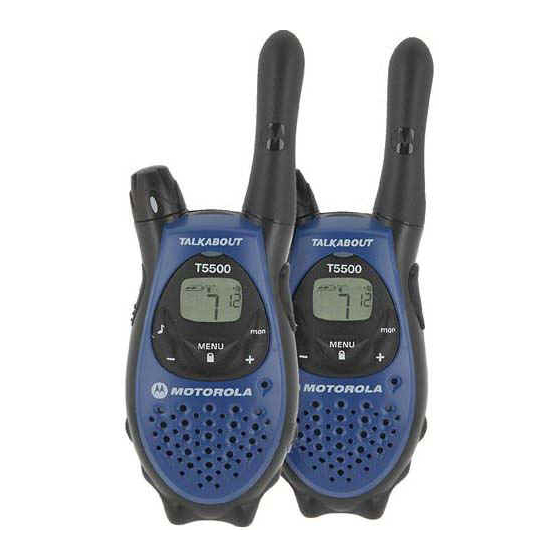Motorola TALKABOUT T5500 Communicatiehandleiding - Pagina 6
Blader online of download pdf Communicatiehandleiding voor {categorie_naam} Motorola TALKABOUT T5500. Motorola TALKABOUT T5500 16 pagina's. Frs/gmrs recreational two-way radios
Ook voor Motorola TALKABOUT T5500: Gebruikershandleiding (36 pagina's), Gebruikershandleiding (17 pagina's), Gebruikershandleiding (5 pagina's)

Locking (programming) channels into memory
Some, but not all, FRS and FRS/GMRS radios have a memory to lock in the channel and
other settings so that accidentally pushing a button doesn't mess up your settings. When
we are doing a drill, or if there is a real emergency, you should lock your radio on the
channel number for our ASNC CERT emergency channel 12 (467.6625 MHz). Usually
you need to adjust the radio to the desired channel, then using the menu (different on
almost all sets so check your User's Guide /Owner's Manual), pick that channel number
for the memory slot and then push your Mode or Select button. To lock it in see item #8
below.
4) Transmit (also called the Talk or Push-to-talk) Button
This is the large button (usually) on the side of a HT*. When the PTT button is held
down the radio transmits and when released it receives. Sometimes the PTT button is
used to capture what has been changed after using the Menu to alter your settings.
5) Setting the transmit power level
In all FRS radios the power is preset at ½ watt. If your radio is an FRS/GMRS it will
usually have a high-low power switch for the GMRS channels. That choice is also
commonly a "Hi-Lo" button on the front of the radio or it is one of the
Menu/Mode/Select options. Radios vary quite a lot as to how they do this. You need to
check this in your radio's User's Guide (instruction manual).
Setting Privacy Codes (Interference Eliminator Codes, CTCSS tones)
6)
These are used to block in-coming transmissions which do not contain the exact tone (a
frequency so low you can't hear it) which your radio is programmed to accept. This
avoids being bothered by in-coming calls that are not intended for you. Setting privacy
codes is accomplished on most radios by pushing your MENU, MODE or SELECT
button and then scrolling by pushing the button one or more times. It is usually the
second largest number on your screen and when you are in the right mode to change it, it
blinks. Then push the UP (+) or DOWN (-) buttons to reach the number you want.
Usually you then push the PTT* button to set that channel, but radios vary on how their
menus work so check your User's Guide (instruction manual). It is not recommended that
you use these in Emergency Communications because it leads to unknowingly interfering
with others using the frequency.
7) "Squelch" and "Monitor" button
The "Squelch" button or knob The squelch is a circuit in the radio receiver which turns
the sound off until it hears a moderately strong signal. If that squelch were not there, you
would hear a constant and annoying hissing sound most of the time. Many FRS and
FRS/GMRS radios have a built in preset squelch circuit which does not need adjusting. A
few have a squelch knob which is adjusted by turning it slowly up to just barely past
where the hissing sound ("static")goes away.
For disaster communication in the ASNC area, tune to FRS Channel 2 (Alternate: Ch 12)
Ham Radio Operators should also tune to Battalion 2 simplex 145.585 MHz, PL 110.9
6
